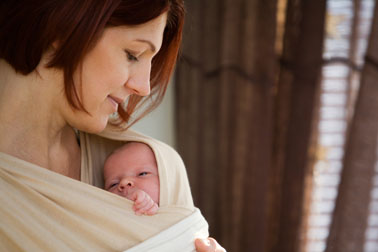 By TreeLiving Originally proposed by John Bowlby, then developed by pediatrician William Sears, attachment parenting focuses on the nurturing connection that parents develop with their children, a connection that is viewed as the ideal way to become independent and empathetic people: to have a trusting attachment to parents during childhood. Because attachment parenting is more about a state of mind than a parenting method there are some characteristics that will help define better what it is. Gentle birth Attachment parenting begins at birth and even before. Attachment parenting advocates believe it is important to eliminate negative thoughts and feelings since pregnancy. Breastfeeding Breastfeeding is the perfect way to create a secure attachment between the mother and the baby. The benefits of the breastfeeding relationship are not just for the baby; the mother benefits greatly from the “happy hormones” secreted during breastfeeding, and from the knowledge that she is doing much to get a close emotional bond. Responsiveness It is one of responsiveness to the infant, responding to cries by meeting needs. Babies can't talk, so crying is their only way to communicate a stress, need, or discomfort. Attachment parenting parents respond to their babies' cries and not let babies cry out loud. Closeness Touch is incredibly important for a baby's development, and attachment parenting embraces that concept to the fullest, advocating keeping the baby nearby at night and in a sling during the day. Co-sleeping, or sharing sleeping space, is part of the goal of closeness among parents who apply attachment parenting. The basic idea is that an attached child will learn to trust his parents and will therefore develop a sense of security and independence. Attached children are confident and develop better social skills; therefore they are able to form strong relationships of their own.
By TreeLiving Originally proposed by John Bowlby, then developed by pediatrician William Sears, attachment parenting focuses on the nurturing connection that parents develop with their children, a connection that is viewed as the ideal way to become independent and empathetic people: to have a trusting attachment to parents during childhood. Because attachment parenting is more about a state of mind than a parenting method there are some characteristics that will help define better what it is. Gentle birth Attachment parenting begins at birth and even before. Attachment parenting advocates believe it is important to eliminate negative thoughts and feelings since pregnancy. Breastfeeding Breastfeeding is the perfect way to create a secure attachment between the mother and the baby. The benefits of the breastfeeding relationship are not just for the baby; the mother benefits greatly from the “happy hormones” secreted during breastfeeding, and from the knowledge that she is doing much to get a close emotional bond. Responsiveness It is one of responsiveness to the infant, responding to cries by meeting needs. Babies can't talk, so crying is their only way to communicate a stress, need, or discomfort. Attachment parenting parents respond to their babies' cries and not let babies cry out loud. Closeness Touch is incredibly important for a baby's development, and attachment parenting embraces that concept to the fullest, advocating keeping the baby nearby at night and in a sling during the day. Co-sleeping, or sharing sleeping space, is part of the goal of closeness among parents who apply attachment parenting. The basic idea is that an attached child will learn to trust his parents and will therefore develop a sense of security and independence. Attached children are confident and develop better social skills; therefore they are able to form strong relationships of their own.
What is Attachment Parenting?

